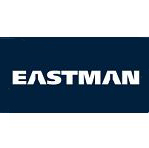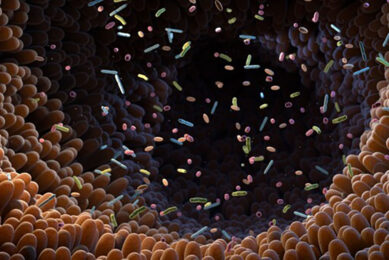Weaning stress: A challenge in high performing piglets
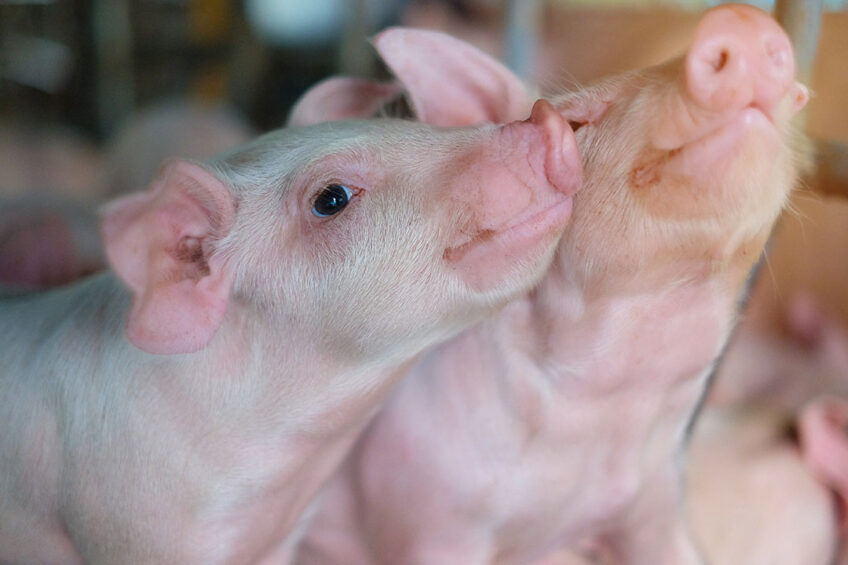
Weaning stress and its consequences can have a lasting impact on health and performance. SCFAs, MCFAs and their glycerol esters play a role in strategies to improve the healthy development and resilience of piglets and reduce the use of antibiotics.
The period around weaning is stressful. Social and environmental stresses occur as piglets are separated from their mothers and shifted to new environments. At the same time, easily digestible sow milk is replaced with predominantly plant-based solid feed while the digestive tract is still underdeveloped, and the barrier function is still incomplete. Therefore, piglets often show growth depression and are more susceptible to diseases, a phenomenon known as post-weaning stress syndrome. Consequently, a regular pro- and metaphylactic use of antimicrobials as well as therapeutical levels of ZnO, has been the standard approach to keep animals’ productivity. This has been contributing to increasing antimicrobial resistance (AMR), which is one of the world’s most pressing public health issues.
Reducing the need for antibiotic treatments
To significantly reduce the need for antibiotic treatments, the presence and growth conditions of pathogenic microorganisms need to be controlled on the one hand and, and even more importantly, the resilience of the animal need to be improved.
Due to its immature intestinal system, supporting piglets with the most suitable diet becomes crucial to minimise any additional impact on the fragile system of the young animals. Piglet’s secretion of digestive enzymes is limited, which is crucial for optimal protein digestion. Undigested protein can reach the hindgut and become a substrate for the growth of pathogenic bacteria, leading to physiological imbalances and serious health issues. Since pepsin has a pH optimum of 2 (Figure 1), organic acids can be used to ensure that this pH optimum in the gastrointestinal tract is met, even in feed with high buffer capacity, such as piglet starter feed.
Figure 1- Activity curve of the protein degrading enzyme pepsin.
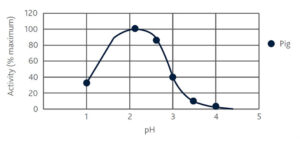
(Crèvieu-Gabriel et al., 1999, adapted)
The benefit of monoglycerides
Organic acids are widely used for their growth-inhibiting potential on pathogenic bacteria in feed, as well as for their impact on the intestinal microflora. Combining different organic acids to modulate the gut microflora and control a broader spectrum of pathogenic bacteria strains is the most effective strategy. The combination of SCFAs and MCFAs is even more interesting, this can ultimately prevent postweaning diarrhoea, by lowering intestinal pH and directly reducing E. coli virulence.
The structural change of the organic acid by esterification with glycerol makes the fatty acid derivative even more effective in inhibiting pathogenic bacteria. This improvement of the inhibitory capacity could be demonstrated on several pathogenic bacteria strains and fatty acids of different chain.
Figure 2- The difference in inhibiting capacity of MCFAs and their monoglyceride derivatives on selected bacteria strains that includes S. suis.
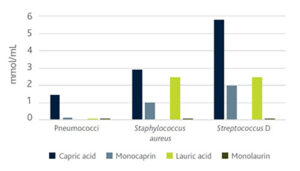
Gut development and barrier function
Lipopolysaccharides (LPS), which are an integral part of the outer membrane of gram-negative bacteria such as E. coli and S. enterica, induce a pro-inflammatory response in the animal and play an important role in the pathogenesis of gram-negative bacteria infection. The immune cell response and chronic inflammation can damage tight junctions and gut barrier function.
Weaning stress leads to long-term damage to the gut barrier function, affecting tight junction proteins, which are not recovered 14 days after weaning. An addition of butyric acid glycerides via feed could assure continuous availability throughout the digestive tract. Butyric acid derivatives are known to have antimicrobial, anti-inflammatory, and antioxidative effects that are important for maintaining gut health and improving the barrier function. Butyric acid derivatives have demonstrated a clear benefit to intestinal development.
Literature on butyric acid in humans and animal models indicates the important role it plays in the development of immunity. Butyric acid can affect innate as well as adaptive immune cells. It has been shown to induce T-cell differentiation but also to modify macrophage activity against pathogenic bacteria.
Our own trial results in weaning piglets confirmed significant beneficial effects of butyrate on leucocytes and on the content on the further differentiated monocytes and eosinophils. This is in line with lower levels of the inflammatory marker haptoglobin in supplemented groups, suggesting improved immune function (Figure 3). Less severe inflammation also means less oxidative stress, indicated by higher vitamin E levels which were also observed in butyric acid-supplemented weaning pigs and were still present 41 days after weaning. Reduced stress and a reduced impact on the immune system in the end is also beneficial for performance as indicated by the improved feed conversion ratio in Figure 3.
Figure 3- Impact of butyric acid (BA) from various products on inflammatory marker haptoglobin and FCR.
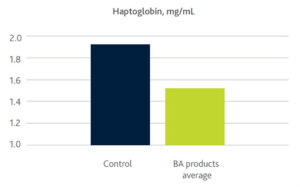
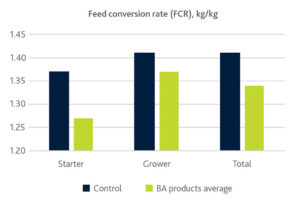
Conclusion
Feeding concepts that include various SCFAs, MCFAs and their glycerol esters address important factors associated with the problem of weaning stress and are therefore an essential part of strategies reducing the need for antibiotic treatment at weaning.
Contact the Eastman team more information
References are available on request.


